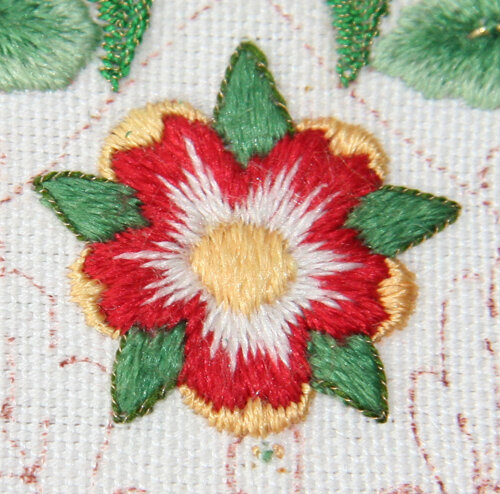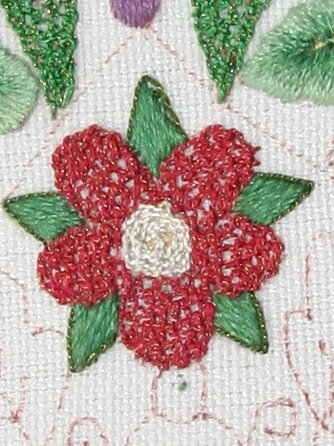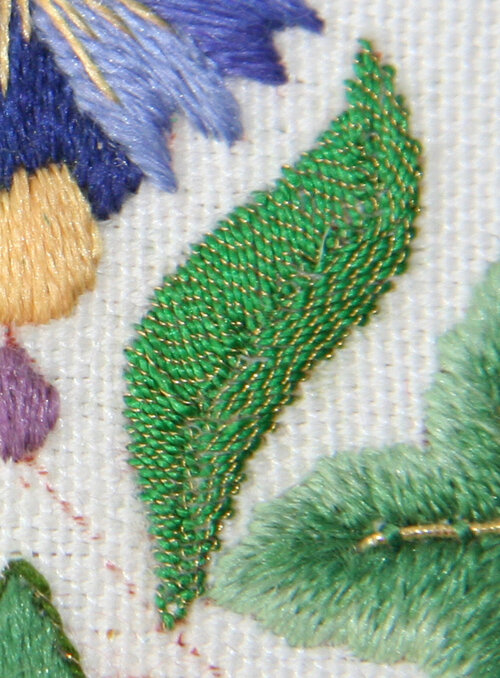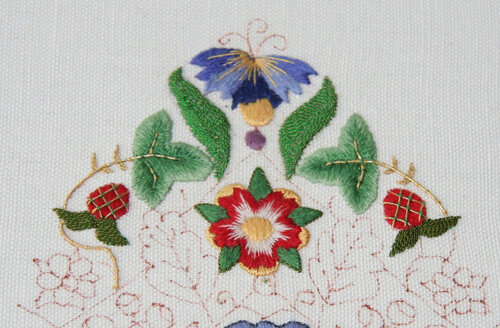Everything smaller in scale
The rose below is only 1 inch/2.5 cm long. It's little. The entire face of one side of the cap is only 4.5 inches/11 cm tall and 4 inches/10 cm wide. The cap is a miniature version of a full sized cap.The key words in these sentences are "little and miniature".For a while now I haven't been at all happy with how this whole project was progressing. Everything looked clumsy; more like a child's crayon drawing than a delicate piece of needlework. Of course, I asked Nicola about this and her insight was invaluable. When working something in miniature, everything has to be scaled down. Not just the pattern, but the materials and the stitches as well. Above you see the new, done to scale rose. Below the old version using the thicker (but oh so beautiful!) Gilt Sylke Twist. Of course the design has changed a bit so it's more detailed but I could do that using silk and I couldn't using the GST.
When working something in miniature, everything has to be scaled down. Not just the pattern, but the materials and the stitches as well. Above you see the new, done to scale rose. Below the old version using the thicker (but oh so beautiful!) Gilt Sylke Twist. Of course the design has changed a bit so it's more detailed but I could do that using silk and I couldn't using the GST. The other thing I decided to do was to simplify the stitches I was using in such a small space. I wanted to use the GST because I think it's just beautiful thread. However, this meant finding stitches that showed off the thread and didn't detract from the design.Simple stitches work best, Nicola suggested. She really liked the little leaves on either side of the strawberries and they're done in straight stitches (a sort of satin stitch but so small and not padded) with GST.I did a little test on the leaf sampler I shared with you earlier and discovered that fly stitch works up easily with GST and looks very nice. This is the first leaf I did and it's pretty good. Some of the stitches need scootching a bit to even them up but it's easy to do that with GST! I'll be couching a center vein of gold thread, snuggled in the little trough that fly stitch creates.
The other thing I decided to do was to simplify the stitches I was using in such a small space. I wanted to use the GST because I think it's just beautiful thread. However, this meant finding stitches that showed off the thread and didn't detract from the design.Simple stitches work best, Nicola suggested. She really liked the little leaves on either side of the strawberries and they're done in straight stitches (a sort of satin stitch but so small and not padded) with GST.I did a little test on the leaf sampler I shared with you earlier and discovered that fly stitch works up easily with GST and looks very nice. This is the first leaf I did and it's pretty good. Some of the stitches need scootching a bit to even them up but it's easy to do that with GST! I'll be couching a center vein of gold thread, snuggled in the little trough that fly stitch creates. I also added rich golden yellow to the blue flower at the top. The color is repeated in the rose in the middle and will be in the purple flowers at the bottom. This spark of color really lifted the whole piece. When all the gold is added, it will really shine!
I also added rich golden yellow to the blue flower at the top. The color is repeated in the rose in the middle and will be in the purple flowers at the bottom. This spark of color really lifted the whole piece. When all the gold is added, it will really shine! The large leaves in the middle need to be less heavy, I think. This is where I'm planning on doing the corded Brussels stitch with gold and silk. In looking at old pieces of embroidery, there are many examples of leaves worked in two colors of green. Sometimes the colors are split horizontally and other times vertically. These will have the more yellow green on the outside half and the more blue green on the inside half. The yellow green of the strawberry leaves will flow down the outside of the pattern and the more blue of the rose leaves will flow down the center of the pattern. At least, that's the plan!Working out all of this on the first panel is interesting, frustrating and fun. It will be glorious when it's finished and I can concentrate on just stitching the other 3 panels!
The large leaves in the middle need to be less heavy, I think. This is where I'm planning on doing the corded Brussels stitch with gold and silk. In looking at old pieces of embroidery, there are many examples of leaves worked in two colors of green. Sometimes the colors are split horizontally and other times vertically. These will have the more yellow green on the outside half and the more blue green on the inside half. The yellow green of the strawberry leaves will flow down the outside of the pattern and the more blue of the rose leaves will flow down the center of the pattern. At least, that's the plan!Working out all of this on the first panel is interesting, frustrating and fun. It will be glorious when it's finished and I can concentrate on just stitching the other 3 panels!
